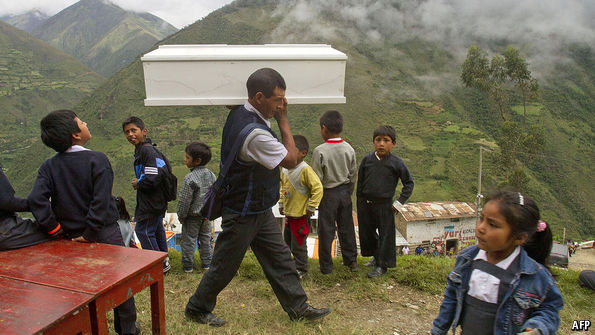Unearthing the pastA new hunt for remains of victims of Peru’s internal conflict
The government strives to investigate atrocities without reviving anger
THE threat posed to Peru’s democracy by the Shining Path, a leftist guerrilla army, has ended, but memories of the war it waged against the state in the 1980s and 1990s are still raw. Nearly 70,000 people died or disappeared during the conflict. A truth and reconciliation commission issued a report in 2003, apportioning guilt roughly evenly between the government and the Maoist rebels. It did not foster understanding between the vast majority of Peruvians who despise the insurgents—who often behaved more like terrorists than guerrillas—and the few who are still drawn to it.
Recently Peruvians have been reminded of their differences. Last year a mausoleum for members of the Shining Path who died in a prison uprising in 1986 opened in Lima, the capital. Politicians denounced it; the biggest party in congress introduced legislation in November to add symbols and monuments to the list of things that could be classified as an “apology for terrorism”, a criminal act. On February 14th this year Peruvians marched to commemorate the 25th anniversary of the murder in Lima of María Elena Moyano, a leftist politician, by the Shining Path. “I remember and want others to understand,” said Rosalina Meza, a marcher who witnessed Moyano’s murder. Later in February, 12 Shining Path leaders, already jailed for terrorism and other crimes, went on trial for masterminding a car bombing in Lima in 1992 that killed 25 people and injured hundreds. The trial is expected to last for months.
The government of Pedro Pablo Kuczynski is eager to encourage forms of commemoration that heal wounds rather than reopen them. A law passed by congress last June, before Mr Kuczynski took office, established a department in the justice ministry to search for the remains of people who disappeared between 1980 and 2000. It is expected to begin its investigation this month. Just 1,600 bodies were found in earlier searches. Unlike those earlier efforts, the new investigations will not attempt to assign responsibility for what happened. Their main purpose will be to return victims’ remains to their families. “This completely changes the dynamic,” says Marisol Pérez Tello, the minister of justice and human rights, who sponsored the original legislation.
The search will start in the highland region of Ayacucho, where the Shining Path began its war and where, according to the truth commission, 40% of the deaths and disappearances occurred. The justice ministry thinks the region could hold 6,000 mass graves. But the mission may not avoid the rancour caused by earlier efforts to memorialise victims, Ms Pérez Tello acknowledges. Relatives whose remains are returned may demand justice. “Bad elements” in the army may be among the defendants if the discoveries lead to new trials, she says.
And the war has not quite ended. Remnants of the Shining Path continue to operate in a Belgium-sized area of rugged terrain, called VRAEM, which includes two provinces in Ayacucho. Their last big attack, in April 2016, killed eight soldiers and two civilians. The area remains under a state of emergency. The two brothers who lead the group, Víctor and Jorge Quispe Palomino, are on the United States’ terrorist list. A poll by Ipsos late last year found that nearly a quarter of Peruvians think the Shining Path is reviving and attracting new members. As long as they think the menace is growing, it will be hard to bury grudges from the war.
Recently Peruvians have been reminded of their differences. Last year a mausoleum for members of the Shining Path who died in a prison uprising in 1986 opened in Lima, the capital. Politicians denounced it; the biggest party in congress introduced legislation in November to add symbols and monuments to the list of things that could be classified as an “apology for terrorism”, a criminal act. On February 14th this year Peruvians marched to commemorate the 25th anniversary of the murder in Lima of María Elena Moyano, a leftist politician, by the Shining Path. “I remember and want others to understand,” said Rosalina Meza, a marcher who witnessed Moyano’s murder. Later in February, 12 Shining Path leaders, already jailed for terrorism and other crimes, went on trial for masterminding a car bombing in Lima in 1992 that killed 25 people and injured hundreds. The trial is expected to last for months.
Latest updates
And the war has not quite ended. Remnants of the Shining Path continue to operate in a Belgium-sized area of rugged terrain, called VRAEM, which includes two provinces in Ayacucho. Their last big attack, in April 2016, killed eight soldiers and two civilians. The area remains under a state of emergency. The two brothers who lead the group, Víctor and Jorge Quispe Palomino, are on the United States’ terrorist list. A poll by Ipsos late last year found that nearly a quarter of Peruvians think the Shining Path is reviving and attracting new members. As long as they think the menace is growing, it will be hard to bury grudges from the war.

No comments:
Post a Comment